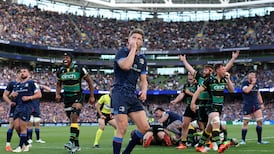Icons of Identity marshals and explores nine iconic presences from the last two millennia which had an active - and in many respects a continuing - role in shaping Northern Ireland as it is now. It is an exhibition of pictures, objects and texts that constitute fragmentary narratives of conflicting meanings. Most of the icons are Janus-faced in the sense that, depending on the communal vantage point from which you happen to view them, they may be good or bad, liberators or oppressors. Cu Chulainn, the Virgin Mary, the crucified Christ, St Patrick, Erin, King William III, Sir Edward Carson, the Battle of the Somme and Michael Collins are all presented in terms of the use society makes of them in constructing images of itself.
Broadly speaking, iconography relates to the study of artworks in terms of their imagery. Iconology has the added implication of dealing with symbolic systems of imagery within cultures as sometimes obscure expressions of cultural character or identity, embracing unintended as well as intended meanings. Icons of Identity is simultaneously an exercise in iconography and iconology. It traces representations of its chosen icons through a variety of times and contexts, but it also engages with their underlying meanings for their particular society.
An obvious example here is the Battle of the Somme, still seen as being linked to the Battle of the Boyne in the Unionist imagination. In the exhibition, it is personified in the form of a soldier, Lt Francis Thornely, who survived the battle and was the model for J.P. Beadle's famous painting of the Ulster Division's fateful attack on July 1st, 1916. This work usually hangs in Belfast City Hall - in fact, this is the first time it's been shown elsewhere. By virtue of his role in both battle and painting, Lt Thornely became a celebrity in Ulster, symbolising the province's role not only in the battle but also in the Great War. As it happens, however, he was not Irish, but English. He ended up in the Ulster Division because his Scottish uncle happened to be a senior officer in it.
One of the ironies about perceptions of Ulster's role in the war is the awkward fact - until lately unacknowledged by just about everyone but a few vocal commentators - that casualty figures for soldiers from the South were on a par with those from the North. Furthermore, there was suspicion among some Unionists that, in the great tradition of military thinking, British commanders had been particularly profligate with the lives of soldiers from elsewhere for a variety of nefarious motives.
So the Somme has a peculiar, tortuous position in the present day context in the North - a symbol not only of Ulster's patriotic sacrifice but also, as witnessed in its recurrence in murals (which continue to feature Lt Thornely, incidentally), of its readiness to stand in isolation from a duplicitous British establishment. One mural, for example, equates Pte W. McFadzean VC with William Millar, who, while armed with a sub-machine gun and travelling in a stolen car, was shot dead by the RUC.
Such complexities, ironies and contradictions run through accounts of many of the nine icons. There is Cu Chulainn, Pearse's "most perfect hero of the Gael" and an archetype of heroic, sacrificial failure in the long Republican struggle.
Ulster Protestant Oliver Sheppard's 1911 sculpture of the purely mythical warrior was nominated by Eamon de Valera as a fitting memorial to the dead of the Easter Rising and placed in the GPO in 1935. Whereupon The Irish Times rather unsportingly pointed out that Cu Chulainn's narrative role was actually as a defender of Ulster against invasion from the South. As murals from both sides of the divide attest, he can plausibly be claimed as an icon by either.
Then there is Sir Edward Carson who, more than any other individual, could be said to have created Northern Ireland and remains the prototypical Unionist political leader. His statue, in defiantly hectoring pose, stands outside Stormont.
But he was a Dubliner "who never lost his Dublin accent and never lived in Ulster". He was a co-founder of the UVF which, in 1914, became a formidable and illegal paramilitary force when over 20,000 rifles were smuggled into Ulster. These arms, the catalogue notes wryly, have never been decommissioned.
Carson was painted by the Belfast-born Sir John Lavery. He and his wife Hazel were close friends of Michael Collins. Hazel Lavery and Collins also feature in their own right in the exhibition. When Lavery was commissioned to provide the image for the Irish Free State banknotes, the American-born Hazel Lavery became Cathleen Ni Houlihan, the personification of Ireland.
Thanks partly to Neil Jordan's persuasive film, Collins remains an incredibly potent Irish icon. But he was also a mass of contradictions, a charismatic lost leader, an utterly ruthless tactician, and a pragmatic politician who endorsed partition.
As an exercise in iconography and iconology, in demonstrating how icons are intricately woven into the cultural fabric and, moreover, how they are identified, shaped and polished to exemplify specific aspects of a particular cultural myth, this exhibition is an instructive experience. That it does all this in the context of Northern Ireland in the current political climate makes it provocative and essential viewing for anyone who can get to see it.










